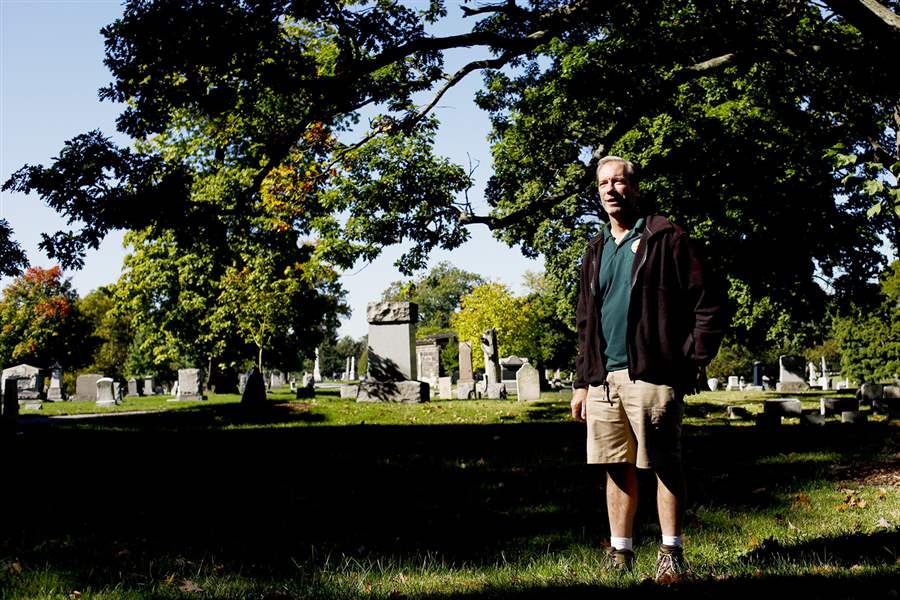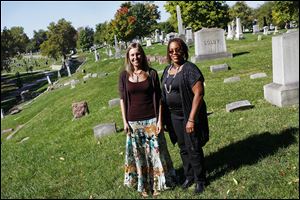
City enlists technology to make cemetery records accessible
Online tool allows anyone to search Toledo’s grave sites
10/13/2013
Doug Trueman, chief horticulturalist for the Toledo Division of Parks, Recreation, and Forestry, pictured at Forest Cemetery in Toledo, has been working on creating a searchable database of about 65,000 records. Some listings on the Cemeteries Record Tracker are from before 1867.
THE BLADE/JEFFREY SMITH
Buy This Image

Doug Trueman, chief horticulturalist for the Toledo Division of Parks, Recreation, and Forestry, pictured at Forest Cemetery in Toledo, has been working on creating a searchable database of about 65,000 records. Some listings on the Cemeteries Record Tracker are from before 1867.
Doug Trueman walked past a row of graves in an old section of Forest Cemetery, pausing in front of a few toppled markers.
A week before, the chief horticulturist with Toledo’s Division of Parks, Recreation, and Forestry was at the same grassy site, where he dug up and swept off several overgrown stones and photographed the markers.
His work is part of a city effort combining history and technology to make cemetery records more accessible to the public.
The city recently launched an online tool — the Cemeteries Record Tracker — that allows people to search for grave-site and burial information at the Web site toledo.oh.gov/gravetracker.
The database of about 65,000 cemetery records includes some listings from before 1867, when an office fire destroyed Forest’s earliest records that dated back to its establishment in the 1830s.
“This is 1849,” Mr. Trueman said, pointing to a marker. “So the only information we have about this person is what we can glean from the headstone, because all of those early records were lost. So, this is the kind of information that we’re documenting and trying to put in the database, but it’ll ... be a multiyear project.”
The project began around 2010, when city staff started talking about how to make cemetery records available online.
Record-keeping has advanced from years ago, when burial information was scrawled in elegant — if sometimes hard to read — handwriting in large ledgers. The city began tracking burial information using various computer programs as that technology became commonly available. Over the years, the data was transferred from one program to the next, creating multiple copies of records.
One big task city staff undertook before posting the database online was to clean up the listings, removing duplicates and correcting mistakes. For each discrepancy unearthed, staff checked records against the available original paperwork, said Tim Burns, manager of the division. The process eliminated roughly 30,000 duplicate or incorrect listings.
“It’s been a labor of love, certainly not finished, but very interesting. And I think we have people who are very passionate about getting the information in there,” said Linda Nelson, an administrative specialist who helped with the project.

Senior clerks Kerstan Kaminski, left, and Shanda Barnhill of Toledo's Parks, Recreation, and Forestry Department have been working on the database.
The group who worked on the project plan to add more listings from Forest, where city staff estimate there are several thousand people buried whose only remaining record is inscribed in stone; and also from Haughton, State Line, Collingwood, and Maplewood, Toledo’s other public cemeteries. The bulk of the listings presently available online are from Forest and Maplewood.
“It’s a huge leap forward for us to make this available to the public, but the database is not complete. And in part it’s as accurate as we have had time to make it. ... We’re still working on improving it,” Mr. Trueman said.
The project was completed internally, so the main expense to launch the online tool was staff time spent researching records and programming, according to a city spokesman.
Internet users can search for records using first or last names, or the dates of birth, death, and burial. They also can use that information to fine-tune a result. Entering the last name “White,” for example, brings up 292 records. Specifying that the first name begins with the letter “A” narrows those results to 18.
What information comes up with each record varies by listing. The records can include the name, dates of birth and death, funeral home, cemetery, and the section, lot, and row where the deceased is buried.
Eventually, Mr. Burns wants to link photographs of markers to the listings and a cemetery map that shows users where in the cemetery a grave site is located.
City officials believe the information will be helpful to those doing research.
Senior clerks Shanda Barnhill and Kerstan Kaminski routinely take calls from people seeking information about a grave site location or wondering how many people with a certain last name are buried at a cemetery. Ms. Kaminski said she’s sometimes on the phone for half an hour helping find records.
Now the two women who helped create the database can point those with Internet access to the Web site to do their own digging.
“It really helps those doing genealogy research. They really appreciate that they can do this from home,” Ms. Barnhill said.
Contact Vanessa McCray at: vmccray@theblade.com or 419-724-6056, or on Twitter @vanmccray.